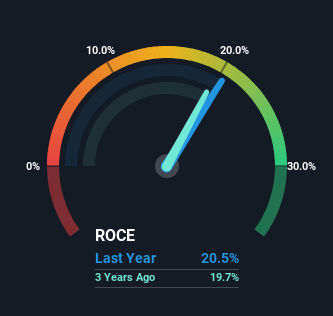- Germany
- /
- Semiconductors
- /
- XTRA:TPE
We Like PVA TePla's (ETR:TPE) Returns And Here's How They're Trending
There are a few key trends to look for if we want to identify the next multi-bagger. Ideally, a business will show two trends; firstly a growing return on capital employed (ROCE) and secondly, an increasing amount of capital employed. Basically this means that a company has profitable initiatives that it can continue to reinvest in, which is a trait of a compounding machine. And in light of that, the trends we're seeing at PVA TePla's (ETR:TPE) look very promising so lets take a look.
What Is Return On Capital Employed (ROCE)?
For those who don't know, ROCE is a measure of a company's yearly pre-tax profit (its return), relative to the capital employed in the business. To calculate this metric for PVA TePla, this is the formula:
Return on Capital Employed = Earnings Before Interest and Tax (EBIT) ÷ (Total Assets - Current Liabilities)
0.20 = €35m ÷ (€306m - €133m) (Based on the trailing twelve months to March 2024).
Thus, PVA TePla has an ROCE of 20%. In absolute terms that's a great return and it's even better than the Semiconductor industry average of 15%.
Check out our latest analysis for PVA TePla

In the above chart we have measured PVA TePla's prior ROCE against its prior performance, but the future is arguably more important. If you're interested, you can view the analysts predictions in our free analyst report for PVA TePla .
So How Is PVA TePla's ROCE Trending?
We like the trends that we're seeing from PVA TePla. The data shows that returns on capital have increased substantially over the last five years to 20%. The company is effectively making more money per dollar of capital used, and it's worth noting that the amount of capital has increased too, by 136%. So we're very much inspired by what we're seeing at PVA TePla thanks to its ability to profitably reinvest capital.
One more thing to note, PVA TePla has decreased current liabilities to 43% of total assets over this period, which effectively reduces the amount of funding from suppliers or short-term creditors. So shareholders would be pleased that the growth in returns has mostly come from underlying business performance. Nevertheless, there are some potential risks the company is bearing with current liabilities that high, so just keep that in mind.
In Conclusion...
To sum it up, PVA TePla has proven it can reinvest in the business and generate higher returns on that capital employed, which is terrific. Investors may not be impressed by the favorable underlying trends yet because over the last five years the stock has only returned 13% to shareholders. Given that, we'd look further into this stock in case it has more traits that could make it multiply in the long term.
On a final note, we've found 1 warning sign for PVA TePla that we think you should be aware of.
If you'd like to see other companies earning high returns, check out our free list of companies earning high returns with solid balance sheets here.
New: Manage All Your Stock Portfolios in One Place
We've created the ultimate portfolio companion for stock investors, and it's free.
• Connect an unlimited number of Portfolios and see your total in one currency
• Be alerted to new Warning Signs or Risks via email or mobile
• Track the Fair Value of your stocks
Have feedback on this article? Concerned about the content? Get in touch with us directly. Alternatively, email editorial-team (at) simplywallst.com.
This article by Simply Wall St is general in nature. We provide commentary based on historical data and analyst forecasts only using an unbiased methodology and our articles are not intended to be financial advice. It does not constitute a recommendation to buy or sell any stock, and does not take account of your objectives, or your financial situation. We aim to bring you long-term focused analysis driven by fundamental data. Note that our analysis may not factor in the latest price-sensitive company announcements or qualitative material. Simply Wall St has no position in any stocks mentioned.
Have feedback on this article? Concerned about the content? Get in touch with us directly. Alternatively, email editorial-team@simplywallst.com
About XTRA:TPE
PVA TePla
Offers systems and solutions to produce components for energy storage systems, photovoltaic modules, and wind turbines worldwide.
Excellent balance sheet with reasonable growth potential.
Similar Companies
Market Insights
Community Narratives



